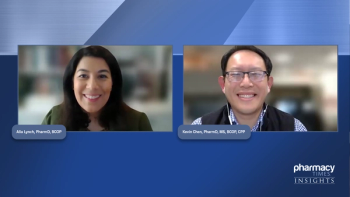
Quality Initiatives in MPNs: Electronic Medical Records and Clinical Pathways
Dr Haumschild leads a discussion about maximizing the impact of care through electronic medical record (EMR) utilization.
Episodes in this series

Ryan Haumschild, PharmD, MS, MBA: One of the things I’ve been working on a lot is how to leverage the EMR [electronic medical record] data and dispensing data. It’s important that we look at dispensing data when we’re identifying patients, because we’re filling for them. A lot of times we have a slightly more intimate feel with them because we control when they get that refill, and we know what their proportion of days covered is like. But at the same time, how do we interface that with the electronic medical record so that we’re looking at patients who we’re not always filling for but we’re aware have been started on therapy and when their follow-up visit is coming?
One of the biggest opportunities as we leverage EMR data is matching up ICD-10 [International Classification of Diseases, 10th Revision] codes and dispensing data so that when I’m in the clinic, I’m not only looking at the patient and saying, “We started this patient with MPN [myeloproliferative neoplasm] on this therapy. How are they doing? Have they called in with any adverse effects?” But when we have a medically integrated specialty pharmacy or pharmacy, we can say, “We know that their proportion of days covered is out of range. They’re not at 100%. How do we do some follow-up?” Or, “We saw this patient called who had an issue with some type of skin adverse effect. How do we make sure they have that supportive care medication earlier so that they’re less likely to abandon therapy and be more compliant?” I’d like to see how we can leverage the EMR and dispense data moving forward.
Many of us, myself included, have external third-party software that we use to manage patients. We do an initial assessment of that patient, part of your accreditation or quality improvement initiatives, and then we see when their next refill is coming. We’ve got to make sure we check in with them and see if they have any adverse effects. “How are things going?” It’s good to have that process in place. It’s important as part of the patient care journey.
But how do we make sure there’s transparency with those data? How do we make sure the care team providers also see that and can act on that information so it’s not just pharmacy, it’s key stakeholders, the provider, the advanced practice practitioner, and the pharmacy working together to improve those outcomes. When you can leverage that integration of data from the clinic to the individuals calling, whether it be the pharmacy technicians or the pharmacist, and even the pharmacy that’s dispensing, then you have coordination of care and everyone is playing off that same sheet of music. I feel like that’s the future in terms of where we’re going.
Improving that is looking at how people integrate their dispensing systems into the EMR. Then you have everyone going to 1 source of information. When you run reports, instead of having to use VLOOKUP to match up those data, which I often do because I’m a data-driven individual, it creates more seamless integration. That’s sometimes where I look at the future of leveraging EMR data in addition to dispense data to make sure all patients are taken care of and not just the ones we dispense for.
Jeff, I don’t know if you have experience [with this]. I’m imagining you’re doing a lot of these quality improvement projects trying to leverage both. What has been your experience leveraging EMR data? Do you look at fill data separately from EMR? Do you try to integrate them? How do you see it moving forward?
Jeff A. Gilreath, PharmD: Going back to the pharmacy technician comment, I can’t say enough good things about our technicians. They keep the clinic running. They leverage EHR [electronic health record] data in terms of signing patients up for patient assistance and co-pay assistance programs and keeping patients on schedule, renewed year after year, without a break in therapy. That’s important, especially with MPNs where a break in therapy can be really detrimental to the patient’s health. Come January, we all sweat a little more in signing everyone up and hoping all the patient assistance programs are renewed on time. That’s one way we’ve leveraged EHR data.
In terms of dispensing and adherence, when we’re able to fill in-house at our own specialty pharmacy, it makes it very easy, like you’re saying. There’s a central location that we can go to. We can easily see exactly when the prescription was sent, when it was filled, and when it was dispensed. That takes some of the guesswork out of following up to ensure adherence with that patient.
Sharita Howe, PharmD: I have a comment I want to add, too. The biggest thing we’ve noticed with utilizing our EMR is to develop activities that will go directly into the EMR. At our practice, the nurses are dropping down the flow sheet or that treatment plan, and from there, we’re putting our data directly into the EMR. If we do our initial education with the patient, we’re dropping it down where it’s an activity, so that way I’m able to run reports in our EMR to determine if there are certain patterns that I need to look for if I need to run a report on a specific patient to see what our previous drug utilization reviews have been for these particular patients. So we actually form an activity.
By placing these data in the EMR, we notice that we receive fewer questions from the nursing staff. Everyone has a central place they can go to in order to see what’s going on with our patients. We even get calls from staff within the clinic, and they’re like, “I was looking at this note, and we noticed that this was going on with the patient.” And, “Thank you, this is how we’re going to move forward.” It’s very exciting to see that happening and to have these conversations.
It’s key that if you’re going to put information into the EMR, to go ahead and develop that activity so that you have a way of collecting these data. We’re able to look at adherence because each month we’re dropping this activity into the patient’s chart and it shows up on the patient’s flow sheet. I can see that if I called this patient on February 15th, I know that we call the patients about 7 days ahead of time. If they tell me they have 20 days of medication remaining, I’m going to say, “What’s going on? It’s not lining up with what’s in our EMR, what we’ve been doing for you over time.” It also allows us to put notes in, like if a patient is on hold because they were having an adverse reaction. We’re able to see the patient over time and calculate these values based on adherence that we’re looking for with our patients. We’re putting activities in the EMRs for these different phone calls that we’re doing for our patients.
Ryan Haumschild, PharmD, MS, MBA: I like how much you’re leveraging the EMR, because I feel like that’s the right thing to do for patient care. Like you said, it puts it out front for all practitioners to see, and people can act on those data.
Transcripts edited for clarity.
Newsletter
Stay informed on drug updates, treatment guidelines, and pharmacy practice trends—subscribe to Pharmacy Times for weekly clinical insights.




